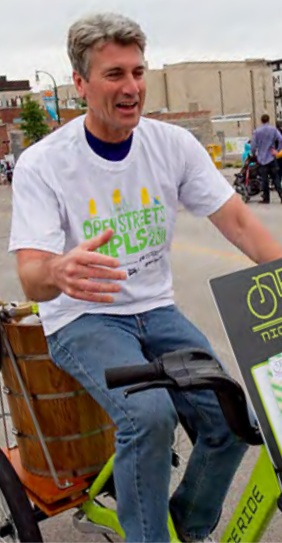Good news out of the Sierra Club Green Transportation Campaign, whose national conservation organizer Rachel Butler brings our attention to Minneapolis's first ever Bicycle Account [PDF]. The compilation of cycling-related data shows a marked increase in the number of cyclists and a steadily decreasing injury rate to go along with substantial investments in bicycle infrastructure on city streets.
According to the report, some 7,000 Minneapolis residents used a bicycle as their primary mode of transportation to and from work in 2010. That's nearly twice as many as in 1990 or 2000, when the number of cyclists stayed relatively flat. And, as a share of all commuters, it's good enough to rank Minneapolis the number two city for bike commuting in the U.S.

The news is yet more evidence that cold weather cities can make cycling an attractive option. In fact, according to the rankings compiled by Copenhagenize, many of the cities with the highest cycling rates are in Northern Europe and Japan. While bicyclists in Minneapolis account for four percent of commute trips, compared to 55 percent in Copenhagen, the number is growing.
"I anticipate that we will see this report as a regular register of our collective bicycle accomplishments throughout the city," Mayor R. T. Rybak writes in the report. "Minneapolis is going to keep at it, and we can all look forward to the benefits as we become a truly welcoming and world-class bicycle city."
The mayor is serious about cycling in Minneapolis, and he has plenty to brag about already, including the launch of the Nice Ride Minnesota bike-share system and the growth of the city's bike network to 167 miles of on-street bikeways, a 75 percent increase from 2010 to 2011 alone.
The report comes on the heels of Minneapolis's first ever Bicycle Master Plan, adopted in July, which set ambitious goals for the growth of the city's bicycle network over the next 30 years. Additionally, in December, the city hired its first full-time bicycle and pedestrian coordinator, Shaun Murphy.
The report also highlighted the city’s steadily improving record of bicyclist safety:
Over the past 18 years, the bicyclist-motorist crash rate decreased from 10 percent to 4 percent. In 1993, there were 298 bicyclist-motorist crashes and about 3,000 regular bicycle commuters. In 2010, there were 273 crashes and nearly 7,000 bicycle commuters.
The city attributes this improvement in part to “safety in numbers,” the theory popularized by researcher Peter Jacobsen, which posits that more cyclists on the street make every cyclist more visible to drivers.
The number of “regular commuters” comes from the U.S. Census and the American Community Survey, but in 2007 the City of Minneapolis inaugurated its own bicycle count in an attempt to measure casual and recreational riders, whom the Census doesn't capture. Since then, the number of bicyclists in the city has grown some 47 percent, from about 22,000 to about 32,000 (the number is higher because it is not strictly limited to city residents). This puts the city on pace to meet its goal of having 35,000 cyclists using its streets by 2014, a 60 percent increase over 2007 levels.






